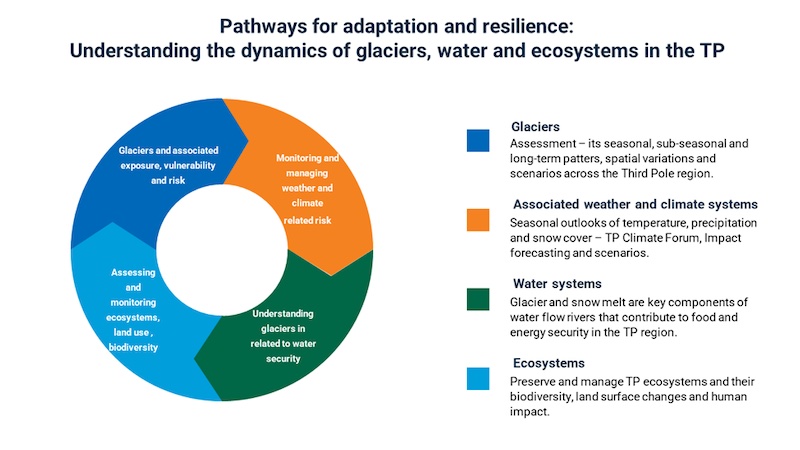Warming Asian Glaciers: Regional Strategy For Riskscape – Analysis

By Sanjay Srivastava, Soomi Hong, Shashwat Avi, Naina Tanwar and Akshaya Kumar
Scientific assessments reveal that the Third Pole (TP), encompassing the vast glaciated mountain systems of Asia, is warming at an alarming rate of over 0.3 ºC per decade, surpassing the global average. The TP hosts the largest ice mass outside the polar region, spanning the Tibetan plateau and surrounding ranges: Pamir-Hindu Kush, Hengduan, Tienshan, Qilian, and the Himalayas.
Rapid changes in the cryosphere and melting of glaciers significantly impact high-mountain ecosystems and downstream regions. As the water tower of Asia, the TP is vital for socio-economic stability through its freshwater resources. Warming has caused considerable variations in lakes, inland water bodies and the runoff into the river basins. Additionally, glacial disasters such as ice collapse and glacial lake outburst floods (GLOFs) have become more frequent and dangerous in recent years.
Emerging Third Pole risk hotspots
While the risks emanating from warming are quite diverse in the different geographies of the TP, glacier melting has been intensifying, with more intensive melting along the Himalayas resulting in emergence of multi-hazard risk hotspots. Recent research reveals that the Hindu Kush Himalayan (HKH) glaciers disappeared 65 per cent faster in 2011–2020 compared with the previous decade.
Future scenarios project that glaciers in the HKH could lose up to 80 per cent of their current volume by the end of the century, with snow cover projected to fall by up to a quarter under high emissions scenarios. This may drastically reduce freshwater for major Asian rivers including the Yangtze, Indus, Ganges, Amu Darya and Helmand. The decreasing extent of frozen ground (permafrost) will lead to more landslides and problems for infrastructure at high elevation.
The changes observed in Asian high mountain cryosphere to date signal grave consequences for human life and nature. A recent example is a cloudburst over Lhonak Lake in North Sikkim, which triggered a devastating GLOF in the Teesta river basin. This event resulted in loss of life, the destruction of the 1,200 MW Urja Hydroelectric Chungthang dam and extensive downstream damage, illustrating how disaster risks can compound and cascade in the fragile mountainous context of the Himalayas.
GLOFs pose a threat to mountainous communities across Bhutan, India, Nepal, and Pakistan; from the Himalayas to the Caucasus, Pamir, Hindu Kush-Karakoram and Tien Shan Mountain ranges. While manifestations of warming Asian glaciers are already visible, they are going to have devastating consequences for water and food security, energy sources, ecosystems, and the lives and livelihoods of hundreds of millions across Asia, many of which will be beyond the limits of adaptation.
Science led TP regional co-operation mechanisms for weather and climate services
Given the transboundary nature of climate threats confronting the Asian glaciers, a stronger regional collaboration and knowledge exchange is required to understand the changing riskscape and develop risk reduction capabilities of the countries in diverse geographies of the TP. The WMO’s Regional Climate Outlook Forums and Regional Climate Centres anchor unique regional and subregional co-operation architecture. Following this modality, the National Meteorological and Hydrological Services of the TP region have establish the Third Pole Regional Climate Centre Network (TPRCC-Network) to facilitate collaboration. To capture the specificities of riskscape across TP geographies, the TPRCC-Network comprises three geographical nodes, with thematic responsibilities for mandatory functions for the entire region. While China leads the northern and eastern nodes, India and Pakistan are leading southern and western nodes of the TP. The Beijing Climate Centre provides overall co-ordination. ESCAP along with ICIMOD, TPE, GCW, GEWEX and MRI are contributing partners of the TPRCC-Network.
In early June, the TPRCC-Network issued its first ever seasonal outlook for the summer season June to September 2024 for a high mountain TP region. It highlights that surface air temperatures are likely to be above normal over most parts of the TP region, especially over the Karakoram. The southwestern and northwestern parts are likely to experience normal to above normal surface air temperatures. Precipitation is likely to be near or above the climatological normal over most parts of the TP region, however, it is likely to be below normal in the western and southeastern parts of the TP region.
Impact forecasting with teleconnection approach in the TP
Weather forecasting relies on the interconnectedness of atmospheric and ocean conditions all the way across the globe, enabling predictions weeks to months in advance. Teleconnections denote significant links between weather phenomena across distant locations, often involving climate patterns spanning thousands of miles. The TP is characterized by hazards of glaciers with their potential exposure, vulnerability and impacts zones which are thousands of kilometers aways across the different nodes. The impact assessment needs to be based on understanding the teleconnections of glaciers and their potential impact zones. With the understanding of these unique teleconnections in the TP, ESCAP is making efforts to translate the seasonal outlook in terms of impact scenarios highlighting potentially at-risk communities, sectors and systems of the TP region. ESCAP has developed automation impact-based forecasting tool to help guide risk informed decision making and fill knowledge gaps.
Support to adaptation at altitude
Several initiatives aim to accelerate adaptation actions in the mountains, including the multi-country initiative such as the Adaptation at Altitude. These initiatives enhance resilience and adaptive capacity by improving and transferring knowledge through science–policy platforms, informing decision-making in national, regional and global policy processes. Adaptation and resilience in the Third Pole context hinge on understanding glacier dynamics and their impact on water and ecosystems. The TRCC-Network is an important initiative to support adaptation at altitude.
About the authors:
- Sanjay Srivastava, Chief, Disaster Risk Reduction Section, ESCAP
- Soomi Hong, Associate Economic Affairs Officer, Disaster Risk Reduction Section, ESCAP
- Shashwat Avi, Consultant, Disaster Risk Reduction Section, ESCAP
- Naina Tanwar, Consultant, Disaster Risk Reduction Section, ESCAP
- Akshaya Kumar, Intern, Disaster Risk Reduction Section, ESCAP








